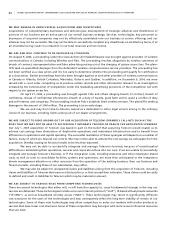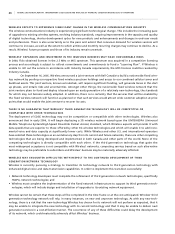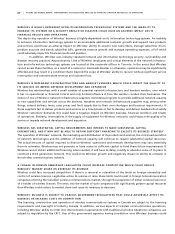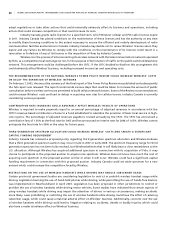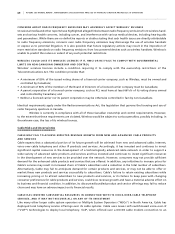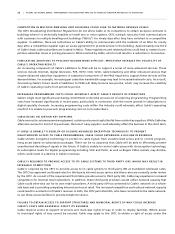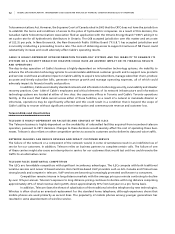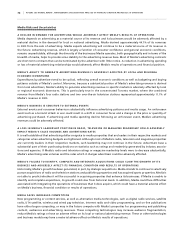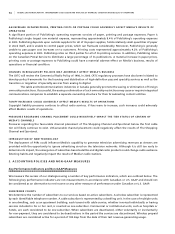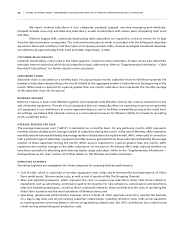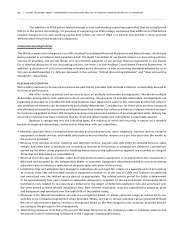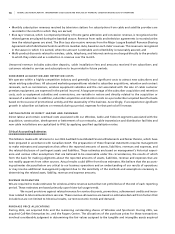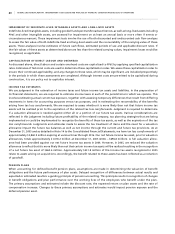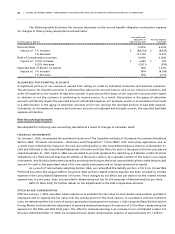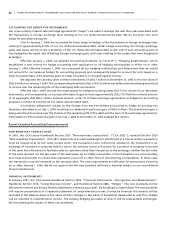Rogers 2005 Annual Report Download - page 76
Download and view the complete annual report
Please find page 76 of the 2005 Rogers annual report below. You can navigate through the pages in the report by either clicking on the pages listed below, or by using the keyword search tool below to find specific information within the annual report.
72 ROGERS 2005 ANNUAL REPORT . MANAGEMENT’S DISCUSSION AND ANALYSIS OF FINANCIAL CONDITION AND RESULTS OF OPERATIONS
Telecommunications Act. However, the Supreme Court of Canada ruled in 2003 that the CRTC does not have the jurisdiction
to establish the terms and conditions of access to the poles of hydroelectric companies. As a result of this decision, the
Canadian Cable Telecommunications Association filed an application with the Ontario Energy Board (“OEB”) asking it to
set a pole rate for all hydroelectric distributors in Ontario. The OEB accepted jurisdiction over this matter and set a rate
of $22.35 per pole. In New Brunswick, the New Brunswick Public Utilities Board (“P.U.B.”) has accepted jurisdiction and
is currently conducting a proceeding to set a rate. The costs of obtaining access to support structures of NB Power could
substantially increase and could adversely affect Cable’s operating results.
CA B L E I S H IG H L Y- D EP E ND E N T U PO N I N F OR M AT I ON T EC H NO L OGY SY S TE M S A N D T HE INA B IL I TY T O E NH A NC E IT S
SY S T EM S O R A S EC U RI T Y B R EA C H O R D I SA S TE R CO U LD HA V E A N A D VE R SE I MP A CT ON I TS FI N A NC I AL RE S U LT S
AN D OP E RA T IO N S
The day-to-day operation of Cable’s business is highly-dependent on information technology systems. An inability to
enhance the information technology systems to accommodate additional customer growth and to support new products
and services could have an adverse impact on Cable’s ability to acquire new subscribers, manage subscriber churn, produce
accurate and timely subscriber bills, generate revenue growth and manage operating expenses, all of which could
adversely impact its financial results and position.
In addition, Cable uses industry standard network and information technology security, survivability and disaster
recovery practices. Over 1,400 of Cable’s employees and critical elements of its network infrastructure and information
technology systems are located at either of two sites: the corporate offices in Toronto and Cable’s Toronto operations
facility. In the event that Cable cannot access either of these facilities, as a result of a natural or manmade disaster or
otherwise, operations may be significantly affected and this could result in a condition that is beyond the scope of
Cable’s ability to recover without significant service interruption and commensurate revenue and customer loss.
Telecom Risks and Uncertainties
TE L E CO M I S H I G HL Y -D E PE N D EN T O N F A C IL I TI E S A N D S ER V ICE S O F T H E I L EC S
The Telecom business is highly-dependent on the availability of unbundled facilities acquired from incumbent telecom
operators, pursuant to CRTC decisions. Changes to these decisions would severely affect the cost of operating these busi-
nesses. Telecom is also reliant on other competitive carriers to access its customers and to deliver its data and voice traffic.
NE T W OR K F A IL U R ES CA N R E D UC E R E VE N U E A ND IMP A CT CU S TOM E R S ER V ICE
The failure of the network or a component of the network would, in some circumstances result in an indefinite loss of
service for our customers. In addition, Telecom relies on business partners to complete certain calls. The failure of one
of these carriers might also cause an interruption in service for our customers that would last until we could reroute the
traffic to an alternative carrier.
TE L E CO M F A CE S SU B ST A NT I A L C OM P ET I T IO N
The ILECs are formidable competitors with significant incumbency advantages. The ILECs compete with both traditional
wireline services and newer IP-based services. Non-facilities-based VoIP providers such as AOL Canada and Primus have
strong brands and compete in telecom. VoIP services are becoming increasingly promoted and known to consumers.
Competition remains intense in long distance markets with the average price per minute continuing to decline
by over 10% per annum. Telecom’s exposure to long distance pricing continues to decline with long distance comprising
approximately 43% of total revenue during 2005, down approximately 50% from last year on a pro forma basis.
In addition, Telecom faces the threat of substitution of the traditional wireline telephone by new technologies.
Wireless is often cited as an eventual replacement for the standard home telephone, although experience shows that
mobile phones are used primarily as second lines. The popularity of mobile phones among younger generations has
resulted in some abandonment of wireline service.




